How the Elbow River Camp came to be
Respected Tsuut’ina Elder reflects on impact of the Stampede on Indigenous communities
— Mount Royal University | Posted: July 11, 2023
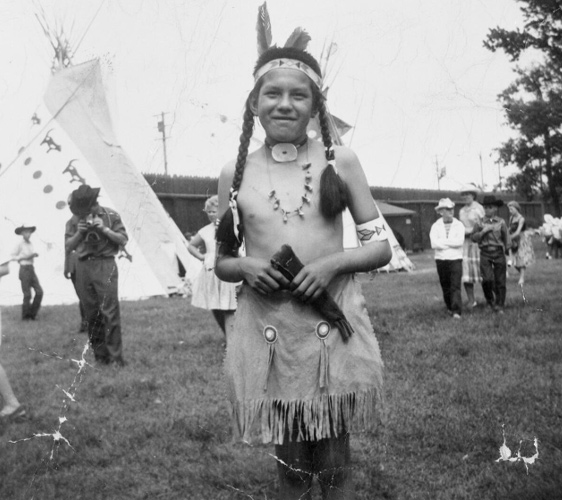
Bruce Starlight, Sarcee (Tsuut'ina), at Stampede grounds, Calgary, Alberta, 1960 (CU1136201), by Unknown. Courtesy of Glenbow Library and Archives Collection, Libraries and Cultural Resources Digital Collections, University of Calgary.
As darkness gives way to dawn over the camp, thin wisps of smoke can be seen rising through the wooden poles that support a massive tipi, one of many positioned in a large circle around a central gathering place. The land, filled with the echoes of drumming and voices rising in song during the day, is quiet on this warm summer morning. The flap of a tipi, illustrated with the visions of a dream, is pulled open and a man steps out and looks towards the rising sun, knowing that the daybreak’s silence will soon be replaced by the sounds of thousands of footsteps and as many voices as people pass by and through the camp to learn about the lives of the people who are waking in their homes away from home.
The man is Spotted Eagle, also known as Bruce Starlight, a respected Elder of the Tsuut’ina, and the tipi is one of two dozen pitched in a corner of the grounds of the “Greatest Outdoor Show on Earth,” also known as the Calgary Stampede. For ten days and nights, the owners of the tipis will live together in the Elbow River Camp, showcasing and celebrating their culture and their stories and competing for top prizes in a range of events.
And today, as Starlight, one of Mount Royal University’s newest honorary doctorate recipients, reflects on the connection between his people and those managing the Stampede, he credits the century-plus relationship with reviving a culture — his culture — that might have been lost had it not been for the rodeo pioneers.
A history with the Stampede from the very beginning
In the early 1900s, the federal government placed numerous restrictions on the traditional pursuits of Indigenous Peoples across Canada. It was a dark time, Starlight says.
“If you practiced the culture, you were punished.”
Punishment could take the form of food being withheld or people being forced to stay on their land, forbidden from venturing out into the quickly expanding western world.
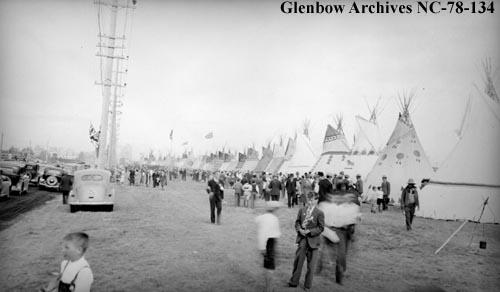
Crowd at Indian Village during royal visit, Calgary, Alberta, 1939 (CU173884), by Unknown. Courtesy of Glenbow Library and Archives Collection, Libraries and Cultural Resources Digital Collections, University of Calgary.
“We need to remember that starvation at the time of the signing of the treaties was prevalent,” explains John Fischer (Cowessess First Nation), interim associate vice-president of indigenization and decolonization at MRU. “Diseases such as influenza swept through our people. In that space and time, it was a common experience.”
For Guy Weadick and the organizers of those first Stampede events, the “Wild West” nature of the show required participation from both “cowboys and Indians,” Starlight says. And, with little concern for government restrictions, they stepped up to invite and include as many of the local Indigenous people as wanted to be part of their new event.
In the very early days, each of the five invited nations that surround the City of Calgary pitched tipis and created villages near the grounds. The Siksika stayed out near Strathmore; the Kainai and the Piikani camped on land across from the Big Four Building; the Iyarhe Nakoda were located in what is now Montgomery, and the Tsuut’ina set up camp in today’s neighbourhood of Killarney in southwest Calgary.
This was a critical time for the Tsuut’ina. “In the 1920s, our population was down to just 120 people,” Starlight says. “If it wasn’t for the Calgary Stampede, the Tsuut’ina might very well have lost their culture.”
Participation a family affair
It's been a few years since he stayed in the camps, and today, at 76 years old, Starlight vividly remembers earlier days, riding on horseback as a young boy through Mount Royal to the grounds, sometimes dressed in cowboy boots and a hat, other times in his traditional attire. He reflects fondly on the excitement of being allowed to stay in the camp at Stampede, of being part of the entire spectacle, from the anticipation of the parade to participating in rodeo events and competitions showcasing Indigenous arts and crafts — especially the beadwork that adorns the horses and clothing — to simply being part of the overall experience.
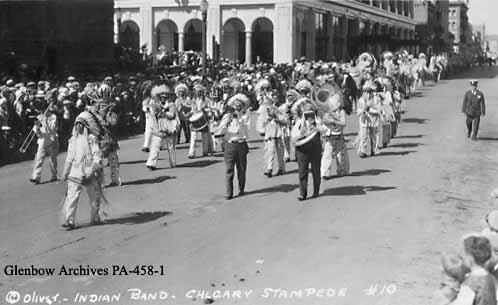
First Nations band, Calgary Exhibition and Stampede parade, Calgary, Alberta, circa 1925 (CU1194448), by Oliver W. J. Courtesy of Glenbow Library and Archives Collection, Libraries and Cultural Resources Digital Collections, University of Calgary.
He thinks about the later days, when the camps were brought together to different locations of the Stampede grounds to form what was called the Indian Village: first near the Corral and then near the Big Four, to the south end of the park, and today in the northeast corner of the park along the river. There were challenges over the years, to be sure: sometimes the ground was too hard to drive the tipi pegs, and at other times, the sod was so new and damp and the pegs pulled right out. The horses were kept in a special paddock that has never been close to the camp; passes to the grounds were limited so that many family members and supporters couldn’t gain easy access; there were floods and even an infestation of garter snakes that slid into the camp from the nearby Scotsman’s Hill; and the location of the camp was moved, more than once.
But these concerns were taken seriously by the Stampede, and over the years, as Starlight came to be known for his leadership in the Indian Village, he also became the bridge between the worlds of Stampede management and his people. As the first chairman of the Indian Village and then the first Indigenous person brought on as a director of the Calgary Stampede Board, his role as champion and mediator meshed.
Tipis make a personal statement
Starlight talks about his family’s tipis, all designed by those who live in them. Handed down in the family through generations, there have been three that he remembers well. The first is a horse tipi, the second a war tipi, and the third, to him, the most personal one of all.
“It came to me in a dream,” he explains. “I was fasting and, in my dream, I saw a bear come across the canvas of the tipi, and as I lifted my head I saw a light at the back of the tipi, and a den and two little newborn bears. I shared my dream with an Elder and he helped me design the tipi, with a winter sky, the sun and the hills where the bears would live.
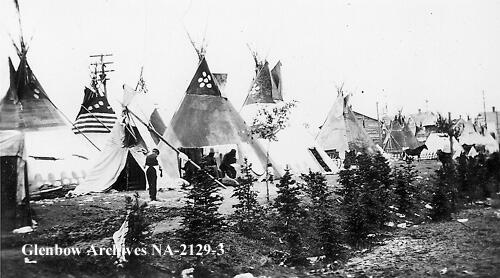
First Nations tipis at the Calgary Exhibition and Stampede, Victoria Park, Calgary, Alberta, 1912 (CU192694), by Unknown. Courtesy of Glenbow Library and Archives Collection, Libraries and Cultural Resources Digital Collections, University of Calgary.
“I’ll be transferring that tipi to my granddaughter this year.”
Starlight and his family have also gifted a tipi to Mount Royal University, which is used for various classes at different schools where Bachelor of Education — Elementary students work and as a place for students to visit and to reflect on reconciliation.
With the gifting of the tipi comes responsibility, Fischer says. “A tipi is a living thing. If you’re gifted a tipi, you should respect it for its way of being and for existing.”
Moving forward, together, in a good way
The Starlight family has worked to build a steady and growing relationship with Mount Royal over the years. Fischer says that, as a leader in his community, Starlight is respected by all. “He is a humble leader who provides input to people in both worlds that is always taken seriously,” he says.
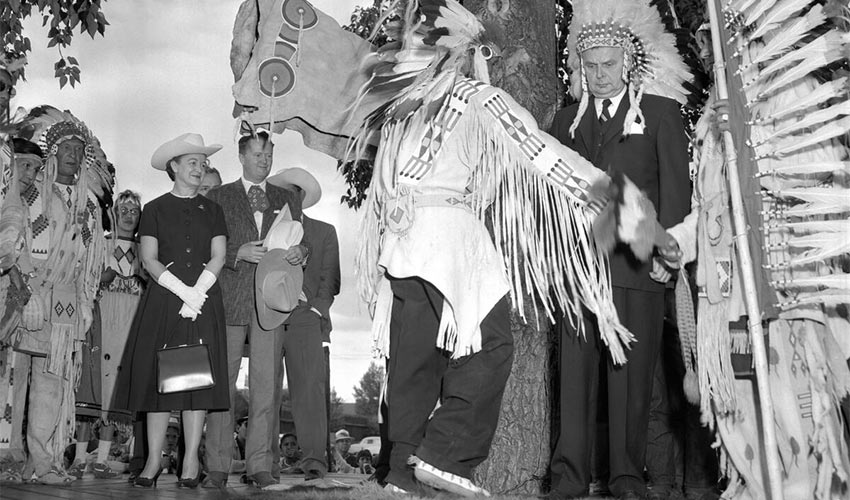
Prime Minister John Diefenbaker at the Indian Village at the Calgary Exhibition and Stampede, Calgary, Alberta, 1960 (CU1132123), by Rosettis Studio. Courtesy of Glenbow Library and Archives Collection, Libraries and Cultural Resources Digital Collections, University of Calgary.
As part of MRU’s engagement around languages, Starlight has taught classes in Tsuut’ina history and has partnered with the Office of Indigenization and Decolonization to co-sponsor curriculum development of Tsuut’ina language and cultural programs. He’s a sitting member of the newly formed Traditional Thinkers Advisory Council, and his voice is welcomed and valued at a critical time in MRU’s history.
“MRU, as an institution, is awakening to the importance of creating connections within the Tsuut’ina and with Bruce specifically,” Fischer says. And the proximity to Tsuut’ina lands has allowed the University to foster more meaningful relationships.
“I attended the dinner organized by his family for Bruce (after the convocation ceremony in which he was awarded his honorary doctorate), and there was much pride and celebration, not only from family, but from community leaders as well.”
The future of the relationship(s)
As he looks forward, Starlight is as confident about his community’s relationship with MRU as he is with the Stampede. And he sees education as an important key. “Teachers are really reaching out,” he says. “If anything is going to change, it’s in the little ones.”
The role for MRU is clear. “As Mount Royal activates its commitment to Indigenous education, engagement of leaders like Bruce is critical,” Fischer says. “The partnerships must contribute to Indigenous student success, the best indicator of reconciliation. Tsuut'ina language and culture has been key in all that Bruce has accomplished and we appreciate that he has let us be a part of the journey.”
“It’s been hard to make headway,” Starlight says, as he thinks about what’s ahead.
“But we’re all getting there.”

